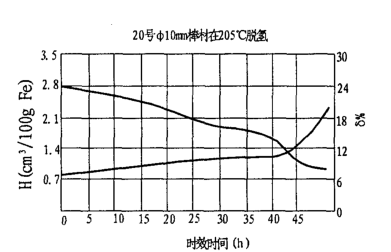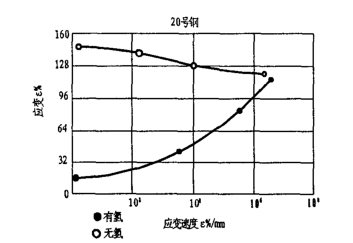Cracking analysis of cold drawn seamless steel pipe
Cracking analysis of cold drawn seamless steel pipe
In the cold drawing process of seamless steel pipes, there are cold work hardening and hydrogen embrittlement, which are the main causes of steel pipe cracking
Abstract: In the cold drawing process of seamless steel pipes, there are cold work hardening and hydrogen embrittlement, which are the main causes of steel pipe cracking. This article analyzes the two phenomena and proposes some measures to prevent steel pipe cracking.
1.Analysis of burst phenomenon
Cold drawn seamless steel pipes are formed by reducing the diameter of seamless steel pipes with a larger diameter through a drawing die. The process route is generally annealing, pickling, and drawing. During the drawing process, the steel pipe sometimes cracks rapidly from beginning to end like splitting a bamboo pole. The author calls this phenomenon cracking. The reasons affecting cracking are: (1) Work hardening; (2) Hydrogen embrittlement.
1. 1 Effect of work hardening
The steel pipe produces a large amount of plastic deformation during cold drawing, causing obvious lattice distortion, thereby increasing the lattice energy and the internal energy of the metal, leading to uneven internal stress of the metal and generating residual internal stress. This increases the hardness of the metal and decreases its toughness. The higher the hardness of the metal, the
The greater the residual internal stress, the more obvious the work hardening phenomenon. When the residual stress reaches a certain value, the metal will tear along a certain column of grain boundaries, forming a crack in the steel pipe.
1. 2 The influence of hydrogen embrittlement
In the process of removing oxide scale with acid solution, sulfuric acid and iron react to produce hydrogen. Hydrogen penetrates into steel in the form of atoms or ions to form a solid solution. The influence of hydrogen on the mechanical properties of steel is typically manifested in hydrogen embrittlement. For example: c 0. 13% of mild steel, of which Mn 0. 62%, Si0. 0%, s 0. 075%, Po. 074%, after annealing at 900°C and after pickling and hydrogenation in a sulfuric acid solution with a concentration of 1:10 for different times, the mechanical properties change as shown in Table 1.
From the data in Table 1, it can be seen that hydrogen has no obvious effect on the yield strength and tensile strength of steel, but it makes the true tensile strength of steel decrease with the increase of hydrogen content, which makes the plasticity of steel, especially the area shrinkage , It decreases sharply with the increase of hydrogen content. The reduction in true tensile strength is mainly due to the premature brittle fracture of steel under the action of hydrogen. As the hydrogen content increases, the yield phenomenon of steel gradually weakens, and even disappears completely, causing hydrogen embrittlement.
| Tensile test performance | After heat treatment | |||||
| Annealing at 900℃ for 1 hour | Acid hydrogenation in 1:10 sulfuric acid solution | |||||
| 30min | 1h | 3h | 5h | 10h | ||
| Yield Strength(Mpa) | 262 | 270 | 272 | 275 | 275 | 275 |
| Tensile strength(Mpa) | 374 | 378 | 380 | 378 | 380 | 380 |
| True tensile strengthMpa) | 924 | 692 | 605 | 551 | 530 | 519 |
| Elongation(%) | 34.0 | 28.2 | 25.4 | 22.4 | 19.3 | 18.9 |
| Area shrinkage(%) | 72.8 | 65.1 | 53.5 | 40.3 | 29.6 | 28.0 |
2 Anti-cracking measures
2. 1 Reduce material hardness
Cold-drawn seamless steel pipe using waste tubing is a relatively simple and effective method. The material of the finished oil pipe is 45 steel, after quenching and tempering, the internal structure is tempered sorbite, and the hardness is relatively high, generally around HB250. Before cold drawing, heat treatment must be used to reduce its hardness. Present
The field uses a complete annealing process. The cooling rate of annealing is different, and the interlayer spacing and hardness of pearlite are also different. It can be seen from Table 2 that the smaller the cooling rate, the larger the interlamellar spacing of pearlite, and the more ferrite content, the lower the hardness of the material. Therefore, in order to obtain a smaller hardness value, the temperature should be lowered at a very small cooling rate. However, if the cooling rate is too low, the productivity is too low. In production, the steel is heated to about 860°C and kept for a certain period of time, then the fire source is extinguished, and the annealing furnace flue and observation hole are closed, so that the oil pipe is slowly cooled with the furnace. When the temperature drops below 500°C, the internal tissue transformation of the tubing has ended, and the pearlite tissue has stabilized. After opening the flue, vent and furnace door, it cools quickly. In this way, the hardness of the material is reduced and productivity is improved. Table 2 shows the condition of medium carbon steel when fully annealed.
| Cooling rate (C/min) | Layer spacing (um) | Organizational form | HB |
| 1 | 0.6-0.7 | Coarse pearlite + ferrite | 170 |
| 60 | 0.35-0.5 | Pearlite + a small amount of ferrite | 210 |
| 600 | 0.25-0.3 | Sorbite | 260 |
2. 2 Elimination of work hardening
In order to improve the plasticity and toughness of cold drawn steel pipes, recrystallization annealing is used. First, the steel tube is slowly cooled at a rate of 100°C/h to 150°C/h to below 200°C, and out of the furnace. Note that the heating temperature should not be too high, otherwise the crystal grains will grow and the mechanical properties will decrease instead.
2. 3 Elimination of ammonia embrittlement
Although hydrogen can cause a sharp decrease in the plasticity of steel, especially the area shrinkage, the aging treatment can remove the hydrogen and basically restore the performance before pickling. See Table 3 and Figure 1.
| Tensile test performance | After heat treatment | |||||
| Aging dehydrogenation after 10 hours of pickling | ||||||
| 100℃ | 200℃ | |||||
| 30min | 1h | 3h | 5h | 10h | ||
| Yield Strength(Mpa) | 272 | 258 | 263 | 253 | 259 | 258 |
| Tensile strength(Mpa) | 380 | 376 | 374 | 372 | 374 | 368 |
| True tensile strengthMpa) | 557 | 723 | 846 | 767 | 821 | 866 |
| Elongation(%) | 20.9 | 26.9 | 29.7 | 31.3 | 33.9 | 35.0 |
| Area shrinkage(%) | 37.0 | 56.7 | 67.6 | 63.5 | 70.0 | 72.0 |


It can be seen from Table 3 and Figure 1 that after aging dehydrogenation, the elongation of the steel is better recovered. The tubing belongs to medium carbon steel and low carbon steel with similar characteristics. In the field operation, the pickled steel pipe is put into the annealing furnace, and the hydrogen is removed with the waste heat.
The characteristic of hydrogen embrittlement is not only that it can be eliminated by aging treatment, but more importantly, it is related to the strain rate. The curve in Figure 2 shows that when the strain rate is high, the effect of hydrogen on the plasticity of steel gradually weakens or even disappears. Therefore, in the actual cold drawing process,
When hardening and equipment capacity permit, it should be drawn with a larger amount of deformation.
3 Conclusion
Through the above, the seamless steel pipe is subjected to the analysis of the cracking in the reduced diameter cold drawing process through the mold, and some measures to prevent the cracking are proposed. In actual production, the manufacturer verified that after adopting these measures, the cracking phenomenon was basically eliminated, and good economic benefits were obtained.

![field:title/]](/uploads/220425/1-22042511053I30.jpg)
![field:title/]](/uploads/220414/1-220414214051492.jpg)
![field:title/]](/uploads/211104/1-211104121004V0.jpg)
![field:title/]](/uploads/211102/1-21110215254UP.jpg)
![field:title/]](/uploads/210923/1-2109231045325B.png)
![field:title/]](/uploads/200915/1-2009151K634949.jpg)
![field:title/]](/uploads/210813/1-210Q31QA0b0.jpg)
![field:title/]](/uploads/210629/1-2106291U944F9.jpg)